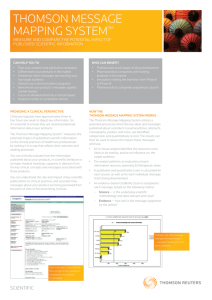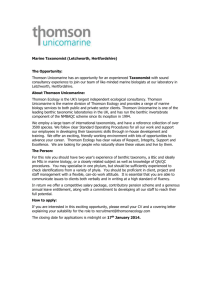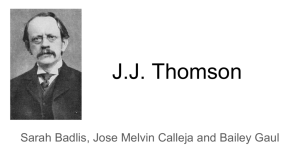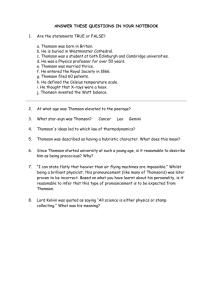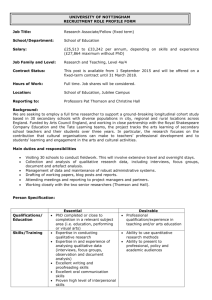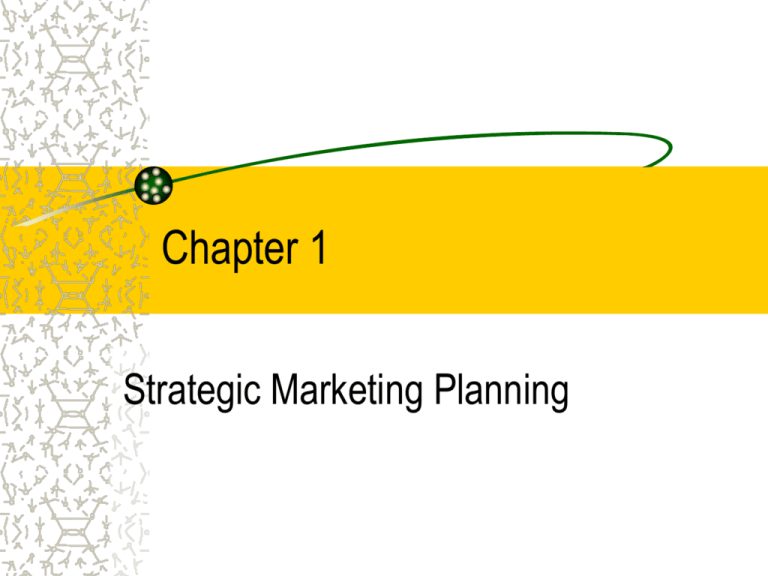
Chapter 1
Strategic Marketing Planning
Strategic Market Planning
Identifying or establishing an organizational
mission, corporate strategy, marketing goals, &
objectives, marketing strategy & a marketing
plan.
COPYRIGHT © 2002 Thomson Learninc, Inc. All rights
reserved..
Marketing Strategy =
Marketing Positioning
Body Shop vs. Avon
Saturn vs. Mercedes
Michelin vs. Continental Tires
Special K Cereal vs. Frosted Flakes
Stouffers vs. Lean Cuisine Frozen Entrees
Purina Dog Chow vs Ol’ Roy Dog Food
COPYRIGHT © 2002 Thomson Learninc, Inc. All rights
reserved..
What is the marketing plan?
A written document that provides the blueprint or
outline of the organization’s marketing activities
– Implementation
– Evaluation
– Control
Represents a “road map” for
implementing the marketing strategy
and achieving its objectives
COPYRIGHT © 2002 Thomson Learninc, Inc. All rights
reserved..
The Strategic Marketing
Planning Process
Situation analysis
SWOT analysis
Determine organizational mission, goals & objectives
Develop business unit strategies
Provide for implementation, evaluation & control
COPYRIGHT © 2002 Thomson Learninc, Inc. All rights
reserved..
Mission Statements...
Address the issue of “what business we are in”
Represent clean and concise statements that
explain the reason for being
In contrast, vision statements deal with
aspirations
COPYRIGHT © 2002 Thomson Learninc, Inc. All rights
reserved..
Mission Statements Address 5
Issues...
Who are we?
Who are our customers?
What is our operating philosophy? (for
example, beliefs, values, ethics, etc.)
What are our core competencies or
competitive advantages?
What are our concerns & interests related to
our employees, community, social issue or the
environment?
COPYRIGHT © 2002 Thomson Learninc, Inc. All rights
reserved..
Concerns About Mission
Statements
If they are too broad, they are meaningless
Overly narrow statements constrain the vision
of the company
Mission statements should be changed less
frequently than other components of the
strategic plan
COPYRIGHT © 2002 Thomson Learninc, Inc. All rights
reserved..
Issues to Consider in Corporate
or Business Unit Strategy...
Competition
Differentiation
Diversification
Coordination of Business Units
Environmental Issues
COPYRIGHT © 2002 Thomson Learninc, Inc. All rights
reserved..
Marketing Objectives...
Must be consistent with organizational goals
Should be expressed in clear and simple terms
Should be expressed in units of measurement
– profitability
– gain in market share
– customer awareness levels
COPYRIGHT © 2002 Thomson Learninc, Inc. All rights
reserved..
Marketing Strategy...
Involves selecting one or more target markets
then developing a marketing mix (product, price,
promotion & distribution) that satisfies the needs
and wants of the target market
COPYRIGHT © 2002 Thomson Learninc, Inc. All rights
reserved..
Marketing Strategy Must…
Fit the needs and purposes of the selected
target market
Be realistic given the organization’s
resources and environment
Be consistent with the organizations
mission, goals & objectives
COPYRIGHT © 2002 Thomson Learninc, Inc. All rights
reserved..
Marketing Implementation &
Control
Implementation is the execution of the
marketing strategy
Requires a customer focus
Must be coordinated with all functional areas
of the organization (product, R&D, human
resources, etc.)
Evaluation and control serves as the
beginning point for the next planning cycle
COPYRIGHT © 2002 Thomson Learninc, Inc. All rights
reserved..
The Marketing Plan
Serves to communicate key information to top
management & line employees
Is an engaging and worthwhile organizational
process
Is prepared by the marketing dept. and approved
by the President or CEO
Is usually developed annually
COPYRIGHT © 2002 Thomson Learninc, Inc. All rights
reserved..
Key Purposes of the Marketing Plan
Explains the present & future organizational
situation
Determines anticipated outcomes
Determines specific actions & who is responsible
Identifies resource needs
Permits monitoring & control systems
COPYRIGHT © 2002 Thomson Learninc, Inc. All rights
reserved..
Strategic Planning in the
Customer-Oriented Organization
Focuses on what buyers want
Uses relationship marketing to build long-term,
mutually beneficial relationships
Develops & responds to marketing intelligence
systems
Decentralizes decision making (> feedback)
Values marketing in the firm
Uses the strategic planning process to build
commitment
COPYRIGHT © 2002 Thomson Learninc, Inc. All rights
reserved..
Examples of CustomerOriented Organizations
Pet Smart
Autozone
Saturn
Dillards
Amazon.com
FedEx
COPYRIGHT © 2002 Thomson Learninc, Inc. All rights
reserved..


